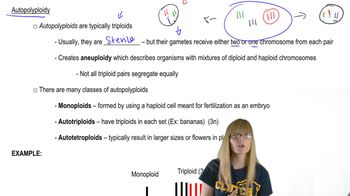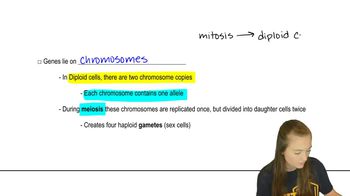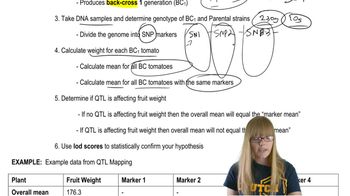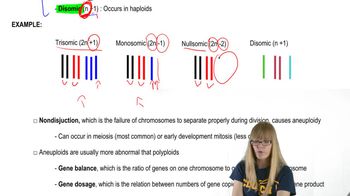Table of contents
- 1. Introduction to Genetics51m
- 2. Mendel's Laws of Inheritance3h 37m
- 3. Extensions to Mendelian Inheritance2h 41m
- 4. Genetic Mapping and Linkage2h 28m
- 5. Genetics of Bacteria and Viruses1h 21m
- 6. Chromosomal Variation1h 48m
- 7. DNA and Chromosome Structure56m
- 8. DNA Replication1h 10m
- 9. Mitosis and Meiosis1h 34m
- 10. Transcription1h 0m
- 11. Translation58m
- 12. Gene Regulation in Prokaryotes1h 19m
- 13. Gene Regulation in Eukaryotes44m
- 14. Genetic Control of Development44m
- 15. Genomes and Genomics1h 50m
- 16. Transposable Elements47m
- 17. Mutation, Repair, and Recombination1h 6m
- 18. Molecular Genetic Tools19m
- 19. Cancer Genetics29m
- 20. Quantitative Genetics1h 26m
- 21. Population Genetics50m
- 22. Evolutionary Genetics29m
6. Chromosomal Variation
Chromosomal Mutations: Aneuploidy
Problem 20
Textbook Question
A plant breeder would like to develop a seedless variety of cucumber from two existing lines. Line A is a tetraploid line, and line B is a diploid line. Describe the breeding strategy that will produce a seedless line, and support your strategy by describing the results of crosses.
 Verified step by step guidance
Verified step by step guidance1
<span>Step 1: Understand the ploidy levels of the parent lines. Line A is tetraploid (4n), meaning it has four sets of chromosomes, while Line B is diploid (2n), meaning it has two sets of chromosomes.</span>
<span>Step 2: Consider the cross between the tetraploid Line A (4n) and the diploid Line B (2n). This cross will produce triploid offspring (3n), as the gametes from Line A will contribute two sets of chromosomes (2n) and the gametes from Line B will contribute one set of chromosomes (n).</span>
<span>Step 3: Recognize that triploid plants (3n) are often sterile because they have an odd number of chromosome sets, which leads to problems during meiosis. This sterility is what results in seedlessness, as the plants cannot produce viable seeds.</span>
<span>Step 4: To develop a seedless cucumber variety, the breeder should focus on producing and selecting triploid plants from the cross between Line A and Line B. These triploid plants will be the seedless variety due to their inability to undergo normal meiosis.</span>
<span>Step 5: Evaluate the triploid plants for desirable traits such as fruit quality and yield, and propagate them vegetatively (e.g., through cuttings) to maintain the seedless characteristic in the new cucumber variety.</span>
Recommended similar problem, with video answer:
 Verified Solution
Verified SolutionThis video solution was recommended by our tutors as helpful for the problem above
Video duration:
2mPlay a video:
Was this helpful?
Key Concepts
Here are the essential concepts you must grasp in order to answer the question correctly.
Polyploidy
Polyploidy refers to the condition of having more than two complete sets of chromosomes. In this case, Line A is tetraploid, meaning it has four sets of chromosomes. This genetic makeup can lead to increased size and vigor in plants, and is often utilized in breeding programs to create new varieties with desirable traits, such as seedlessness.
Recommended video:
Guided course

Autopolyploidy
Diploidy
Diploidy is the state of having two complete sets of chromosomes, which is the typical condition for most plants, including Line B in this scenario. When breeding diploid and polyploid plants, the resulting offspring can exhibit unique genetic combinations, which can be manipulated to achieve specific traits, such as seedlessness in cucumbers.
Recommended video:
Guided course

Diploid Genetics
Hybridization and Backcrossing
Hybridization involves crossing two different lines to produce offspring with combined traits. In this breeding strategy, the tetraploid Line A can be crossed with the diploid Line B to create triploid offspring, which are often sterile and thus seedless. Backcrossing these triploids with one of the parent lines can help stabilize the desired seedless trait in subsequent generations.
Recommended video:
Guided course

QTL Mapping
Related Videos
Related Practice




